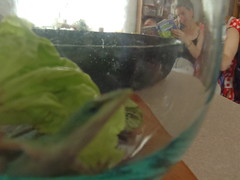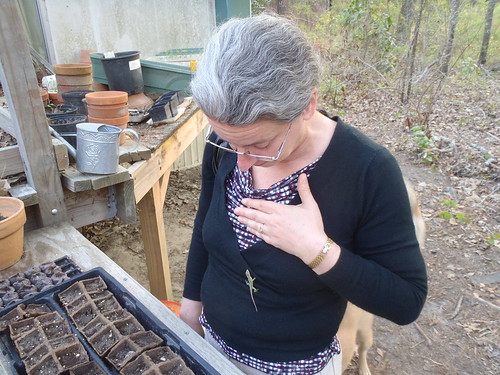
She did not like it in the sink.
She likes it fine but where she drinks.
Not with water, it would get wet!
In a glass with leaves, it can’t get out.
 The lizard didn’t like the leaves.
The lizard didn’t like the leaves.
“I’m a carnivore,” it said.
“Thanks for the water,” and
“Could you let me out to play?”
Beef: Grass-fed versus Grain-fed
Well, I guess if you’re used to the taste of CAFO beef. To me, who was raised on beef from cows in the field, grass-fed beef tastes like beef, and CAFO beef tastes like cardboard.Could a grass-fed cut, with its lower-fat content, rival a grain-fed cut? Yes: It was succulent, buttery, and robust, with a perfectly caramelized crust. The juices formed a simple, rich sauce.
Is it better for you?
Grass-fed beef is lower in calories, contains more healthy omega-3 fats, more vitamins A and E, higher levels of antioxidants, and up to seven times the beta-carotene.Does it cost more? Yes, but in my experience I don’t need to eat a lot of it to feel full and get the taste. Your experience may vary.
Perhaps the most interesting part is that this article is in a mass-market magazine. Which also gives tips on how to source your own local grass-fed beef. And has a facebook page.
Or come to Valdosta Farm Days and get your local beef there.
-jsq
PS: This post owed to Lindsey.
Privet fishing
First, hook some privet:
Then pull with tractor: Continue reading
GM crops cause organ disruptions —multiple studies
 Gilles-Eric Séralini and colleagues surveyed the state
of research and found
GMOs Linked to Organ Disruption in 19 Studies,
as Jeffrey Smith reports for the Institute for Responsible Technology.
Gilles-Eric Séralini and colleagues surveyed the state
of research and found
GMOs Linked to Organ Disruption in 19 Studies,
as Jeffrey Smith reports for the Institute for Responsible Technology.
…consuming genetically modified (GM) corn or soybeans leads to significant organ disruptions in rats and mice, particularly in livers and kidneys. …9% of the measured parameters, including blood and urine biochemistry, organ weights, and microscopic analyses (histopathology), were significantly disrupted in the GM-fed animals. The kidneys of males fared the worst, with 43.5% of all the changes. The liver of females followed, with 30.8%. The report, published in Environmental Sciences Europe on March 1, 2011, confirms that “several convergent data appear to indicate liver and kidney problems as end points of GMO diet effects.” The authors point out that livers and kidneys “are the major reactive organs” in cases of chronic food toxicity.And these were the corn and soybeans that people eat.
Here’s the study.
Why didn’t we know about this long ago? Continue reading
Thunder and lightning
 That’s not dawn in the picture to the right;
the camera is facing north in the middle of the night.
Trees blew down in
this storm:
That’s not dawn in the picture to the right;
the camera is facing north in the middle of the night.
Trees blew down in
this storm:
Video by Gretchen Quarterman, Lowndes County, Georgia, 5 April 2011.
Once it got closer, it was more lightning than thunder: Continue reading
Good thing I bought oil for the chain saw
Good thing I bought oil for the chain saw: Continue reading
Loblolly pine pollen
We have lots of these, but not many with limbs like this so close to the ground. This one is in a cemetary with no close competitors, so it spread out more than up.
Pictures by John S. Quarterman, 27 April 2011, in the Revolutionary War Cemetery in Louisville, Georgia.
-jsq
Copperhead and little dogs
Brown Dog didn’t get bit, but Yellow Dog did. Continue reading
How many raw milk drinkers?
 A lot more than most people think, or that the CDC has said much about.
A lot more than most people think, or that the CDC has said much about.
Steve Bemis digs into the Population Survey Atlas of Exposures, 2006-2007
It was huge, conducting telephone interviews with 17,372 interviewees representing a population of 45,883,553 people in the listed ten states, from May 2006 to April 2007.So, how many raw milk drinkers? Continue reading
Burned-over longleaf
The yellow dog is right: I burned those trees! Before picture of one of them: Continue reading





